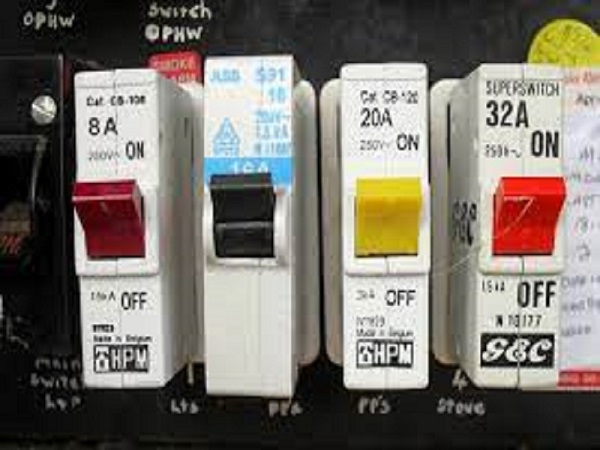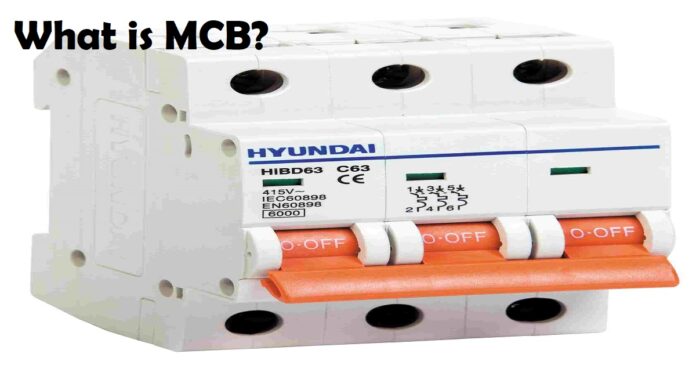What is an MCB (Miniature Circuit Breaker)
In the event of an overload or short, a miniature circuit breaker (MCB) is a type of electrical switch that instantly reduces the current flowing through an electrical circuit. An MCB can be reset by just flipping a switch, contrary to how a fuse operates, which requires replacement after being tripped. MCBs are also more precise than fuses, as they are designed to trip at specific amperages. As a result, they can offer better protection for electrical circuits.
MCBs are also electromechanical devices containing both thermal and electromagnetic elements. The thermal element is designed to respond to increases in temperature. In contrast, if there is a current overload, the electromagnetic element cuts off the switch. Together, these two elements provide reliable and efficient switching.
This article will cover all exciting information about MCBs (miniature circuit breakers) like their different types, construction, working of MCBs, and their application in different industries. If you are interested to know more about MCBs, please read this article till the end.
What is the primary purpose of a small circuit breaker?
A micro circuit-main breaker’s job is to safeguard an equipment or system against persistent overloading & relatively brief faults, but it can also provide protection from earth faults if the ground faults loop admittance is low sufficient.
Construction of MCBs
The construction of an MCB is relatively simple. Still, it is vital to ensure that all the components are rated for the correct voltage and current. Miniature circuit breakers (MCBs) are molded insulating materials that house silver alloy contacts, which are in turn connected to the incoming and outgoing line terminals. The molded insulating material can be made of different dielectric materials like stiff rubber, glass-filled epoxy, or high-temperature-resistant plastics.
The silver alloy contacts are designed to open or close the circuit when required. MCBs are available in different sizes and ratings to suit the specific application. The main components of an MCB are the contacts, trip coil, and arc chutes. The current travels through the circuit on the contacts.
When an overload or short circuit develops, they are intended to cut the connection. The trip coil is activated by a magnetic field when too much current flows through the circuit, causing the contacts to open.
Different Types of MCBs

When an overload or short circuit occurs, the MCB trips and breaks the connection, preventing the current from flowing further. This action will help prevent damage to equipment and cables and reduces the risk of fire. Based on the categorization of range and sizes, MCBs are available in different sizes and ratings, making it essential to select the right one for the application. For example, a domestic MCB may have a rating of 16A, while a commercial MCB may have a rating of 63A.
In order to consider the amount of current flowing through the circuit, the size of the conductor needs to be considered. Several different types of MCBs are available commercially, which are categorized into three types named as;
- Type B
- Type C
- Type D
Type B MCB
MCBs are designed to trip and disconnect the circuit when there is an overcurrent or a short circuit. Type B MCBs are typically used in household and industrial applications. These MCBs are available in different ratings, such as ten kA, 15 kA, 25 kA, and 50 kA. The rating of an MCB is determined by the maximum current that the MCB can handle before it trips.
Type C MCB
Type C MCBs trip instantly and are ideal for the protection of domestic lighting circuits, small electric motors, and similar equipment where there is a significant inrush of current at switch-on. They are also suitable for the indirect protection of type D consumer units. The time/current characteristic of a Type C MCB means that it will trip very rapidly under high fault current conditions but will not trip under typical overload or short circuit conditions. This feature of MCBs is making them ideal for use in circuits where there is a risk of high inrush currents, such as those containing capacitors or inductors. Type C MCBs are generally used in domestic and light commercial applications.
Type D MCB
A Type D MCB is an arc fault current breaker that trips instantly ten to twelve times for clearing high inductive loads. The Type D MCB is most often used for motor control applications with its multiple breaking capacity. The Type D MCB can also be used for lighting and other loads where high inrush currents. When used for motor control, the Type D MCB is typically installed at the main panel or the secondary of a transformer. The Type D MCB can be used as the main disconnect or as a sub-feed breaker for lighting applications.
A type D miniature circuit breaker (MCB) is designed to trip instantly ten to twelve times the rated current of the breaker when exposed to high inductive loads. The type D MCB is also known as a trip-free or auto-reclosing breaker. The main advantage of type D MCB is that it can trip immediately and automatically without operator intervention, making it ideal for use in areas with a high risk of fire or explosion. Another benefit is that it is unaffected by temperature variations, making it perfect for usage in tough environments.
Examples of applications for many MCBs include x-ray machines, UPS systems, welding equipment and huge winding motors etc.
Working of MCBs Explained
They are typically used in domestic and industrial applications. MCBs are classified according to their operating principle, voltage rating, and current rating. MCBs are generally smaller and more robust than conventional circuit breakers, making them ideal for circuit protection devices. One of the main advantages of MCBs is that they can be quickly and easily reset after an overcurrent event. Due to this property, these MCBs are much more convenient than fuse-based circuit protection devices, which often require replacement after an overcurrent event. Another advantage of MCBs is that they typically have a higher electrical current rating than fuses, meaning that they can provide better protection for electrical circuits. MCBs work by sensing when the current in a circuit becomes too high and then switching the circuit off. It can be done either by using a thermal element that heats up and breaks the connection or by an electromagnetic device triggered by a sudden change in the current flow. Either way, MCBs provide a quick and effective way to protect electrical circuits from damage.
The MCB trips and breaks the connection in the event of an overload or short circuit, stopping the flow of electricity. By doing this, fire-related damage to equipment and cables is reduced.
The working of an MCB is based on the principle of thermal-magnetic protection in which deflection of bimetallic strip due overcurrent heating releases mechanical latch which opens the miniature circuit breaker contacts. When an electrical current flows through the MCB, it heats a bimetallic strip which causes the strip to bend and close the circuit. It further trips the breaker and cuts off the current flow. MCBs are designed to react very quickly to over currents, making them an essential part of any electrical system.
Read More: A Detailed Guide About How Long Does A Car Battery Last Without Driving?
Selecting suitable MCBs for different loads
One of the essential aspects of electrical safety in selecting the right MCB, or miniature circuit breaker, for the job. To prevent overloading and fire risks, you must take the tripping characteristics, breaking capacity, and the number of poles into account while choosing proper MCBs (miniature circuit breakers) for certain loads.
- To match the application requirements, a technician can adjust the characteristic tripping curves of an MCB. For example, a highly sensitive curve is required for equipment protection, while a less sharp curve with a delayed tripping time may be used in areas where occasional overloads are likely to occur, such as in lighting circuits.
- The breaking capacity of an MCB is typically expressed in terms of amps, and it is essential to select an MCB that can safely handle the maximum expected current. The breaking capacity of an MCB is essential because an undersized MCB will not offer complete protection.
- The number of poles means the number of conductors that an MCB can control and protect. This factor is also significant; for example, a three-pole MCB is required for a three-phase supply. Ultimately, by taking all of these factors into account, it is possible to select the most suitable MCB for the job and prevent any potential accidents or disasters.
However, one can carefully select the type of MCB that is well-suited to his intended application by having a technical understanding of it.
Application of MCBs in different fields
MCBs are used in various applications, including computers, domestic appliances, and general-purpose and industrial motor control. In most cases, MCBs are used to protect against overcurrent caused by faults in the system or by external conditions such as lightning strikes. To get protection against undercurrents caused by power outages or other disruptions in electricity supply, a technical person can use an MCB circuit. In either case, MCBs can play an essential role in ensuring the safety of electrical systems.
Computers, domestic appliances, and general-purpose electrical equipment typically use lower-rated MCBs. While industrial and motor control applications require higher-rated devices. In all cases, MCBs provide a high degree of protection against electrical faults, helping to ensure the safe operation of circuits.
Final Words
Miniature circuit breakers are a valuable addition to any electrical system. They can be used in various ways to improve safety and performance. We hope that this article has given you valuable information about miniature circuit breakers and their applications. If you have any questions or need help choosing the suitable miniature circuit breaker for your needs, comment below.
Frequently Asked Questions (FAQs)
Apart from this, if you are interested to know more about How To Install An Electric Water Heater then visit our Home Improvement category.









